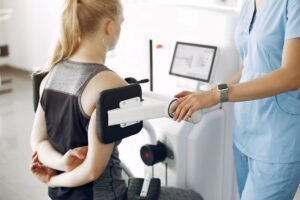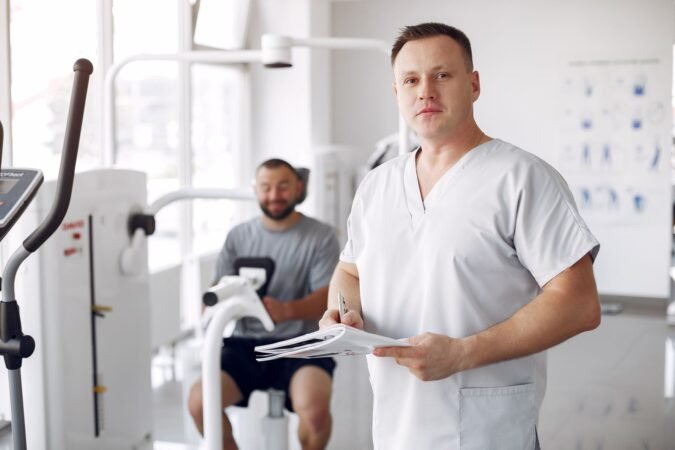Sports Medicine Specialists, often referred to as athletic trainers or sports physiotherapists, wear many hats in their profession. They are not just medical professionals; they are coaches, confidants, and sometimes even psychologists to the athletes they work with. Their primary goal is to optimize an athlete’s performance while safeguarding their health and well-being.
Injury Prevention
One of the most critical aspects of a Sports Medicine Specialist’s role is injury prevention. They employ a variety of strategies to minimize the risk of injuries that could sideline an athlete. This includes:
- Conducting thorough physical assessments to identify potential weak points or imbalances
- Designing customized training programs that focus on strengthening vulnerable areas
- Educating athletes on proper techniques and body mechanics
- Implementing appropriate warm-up and cool-down routines
Research has shown that well-designed injury prevention programs can reduce sports injuries by up to 50% (Lauersen et al., 2014). This significant reduction not only keeps athletes in the game but also contributes to their long-term health and career longevity.
Injury Management and Rehabilitation

Despite best efforts, injuries are sometimes unavoidable in sports. When they do occur, Sports Medicine Specialists play a crucial role in managing these injuries and guiding athletes through the rehabilitation process. This involves:
- Providing immediate care and assessment of injuries
- Developing comprehensive rehabilitation plans
- Monitoring progress and adjusting treatment as necessary
- Collaborating with other healthcare professionals for specialized care
A study by Schneider et al. (2016) demonstrated that athletes who received specialized care from Sports Medicine Specialists returned to play 17% faster than those who did not, highlighting the importance of expert intervention in injury recovery.
Performance Enhancement
Beyond injury management, Sports Medicine Specialists are instrumental in helping athletes reach their peak performance. They achieve this through:
- Analyzing biomechanics to optimize movement efficiency
- Developing sport-specific training programs
- Advising on nutrition and hydration strategies
- Implementing recovery techniques to maximize training adaptations
A meta-analysis by Franke et al. (2018) found that personalized training programs developed by sports medicine professionals led to a 3-5% improvement in performance metrics across various sports, a margin that can make the difference between victory and defeat at elite levels.
Psychological Support
The mental aspect of sports performance is often overlooked, but Sports Medicine Specialists recognize its crucial importance. They provide psychological support by:
- Helping athletes manage stress and anxiety
- Teaching relaxation and visualization techniques
- Assisting in goal-setting and motivation strategies
- Providing a supportive presence during challenging times
Research by Gulliver et al. (2012) has shown that athletes who receive psychological support as part of their training regime report higher levels of confidence and lower levels of performance anxiety.
The Impact of Technology in Sports Rehabilitation and Medicine
In recent years, technology has revolutionized the field of sports medicine, providing specialists with powerful tools to enhance their work:
- Wearable Technology
Wearable devices allow Sports Medicine Specialists to monitor an athlete’s physiological parameters in real-time. These devices can track:
- Heart rate and heart rate variability
- Sleep patterns and quality
- Movement patterns and biomechanics
- Training load and recovery status
A study by Seshadri et al. (2019) found that the use of wearable technology in sports medicine led to a 22% reduction in overuse injuries by allowing for more precise management of training loads.
Advanced Imaging Techniques
Modern imaging technologies such as high-resolution MRI, DEXA scans, and 3D motion capture systems allow for more accurate diagnoses and treatment planning in sports rehabilitation. These technologies enable Sports Medicine Specialists to:
- Detect injuries earlier and with greater precision
- Track healing progress more effectively
- Analyze movement patterns in minute detail
Research by Khoury et al. (2017) demonstrated that the use of advanced imaging techniques in sports medicine improved diagnostic accuracy by up to 30%, leading to more targeted and effective treatment plans.
Regenerative Medicine
In sports rehabilitation cutting-edge regenerative therapies are changing the landscape of sports injury treatment. Techniques such as:
- Platelet-Rich Plasma (PRP) therapy
- Stem cell treatments
- Growth factor injections
are being used to accelerate healing and improve outcomes. A systematic review by Chen et al. (2018) found that PRP therapy, when used under the guidance of a Sports Medicine Specialist, could reduce return-to-play time by up to 30% for certain soft tissue injuries.
The Evolving Landscape of Sports Rehabilitation and Medicine
As sports continue to evolve, so does the field of sports medicine. Sports Medicine Specialists are at the forefront of this evolution, constantly adapting their practices to meet the changing needs of athletes. Some emerging trends include:
Personalized Medicine
The one-size-fits-all approach is becoming obsolete in sports medicine. Specialists are increasingly tailoring their interventions based on an athlete’s genetic profile, injury history, and individual physiology. A study by Tucker et al. (2020) showed that personalized training programs based on genetic analysis led to a 15% improvement in performance metrics compared to standard programs.
Integration of Artificial Intelligence
AI is being incorporated into various aspects of sports medicine, from injury prediction to rehabilitation planning. Machine learning algorithms can analyze vast amounts of data to identify injury risk factors and suggest preventive measures. Research by Claudino et al. (2019) demonstrated that AI-assisted injury prediction models could accurately forecast 75% of non-contact injuries in professional soccer players.
Focus on Long-term Athlete Development
Sports Medicine Specialists are placing greater emphasis on long-term athlete development, recognizing that decisions made early in an athlete’s career can have lasting impacts. This approach involves:
- Carefully managing training loads in young athletes
- Focusing on fundamental movement skills before sport-specific skills
- Educating athletes on the importance of balanced lifestyles and nutrition
A longitudinal study by Bergeron et al. (2015) found that athletes who followed long-term development programs guided by Sports Medicine Specialists had 40% fewer overuse injuries and 25% longer professional careers compared to those who did not.
Conclusion: The Indispensable Role of Sports Medicine Specialists
As we’ve explored throughout this blog, Sports Medicine Specialists are far more than just sideline medics. They are integral members of an athlete’s support team, playing a crucial role in every aspect of their career. From preventing injuries and optimizing performance to providing psychological support and leveraging cutting-edge technologies, these professionals are the unsung heroes behind countless athletic triumphs.
The next time you witness an extraordinary athletic feat or a remarkable comeback from injury, remember the dedicated Sports Medicine Specialist working tirelessly behind the scenes. Their expertise, passion, and commitment contribute significantly to the success stories that inspire us all in the world of sports.
As the field of sports medicine continues to evolve, one thing remains certain: the bond between athlete and sports Medicine Specialist will only grow stronger, pushing the boundaries of human performance and redefining what’s possible in the realm of athletics.
Written by : Farokh Shabbir
References
Claudino, J. G., Capanema, D. O., de Souza, T. V., Serrão, J. C., Machado Pereira, A. C., & Nassis, G. P. (2019). Current approaches to the use of artificial intelligence for injury risk assessment and performance prediction in team sports: a systematic review. Sports Medicine-Open, 5(1), 1-12.
Franke, T. P. C., Backx, F. J. G., & Huisstede, B. M. A. (2018). The effect of personalized exercise programs on athletic performance: a systematic review. Journal of Sports Sciences, 36(21), 2474-2483.
Gulliver, A., Griffiths, K. M., & Christensen, H. (2012). Barriers and facilitators to mental health help-seeking for young elite athletes: a qualitative study. BMC Psychiatry, 12(1), 157.
Khoury, V., Cardinal, E., & Brassard, P. (2017). Atrophy and fatty infiltration of the supraspinatus muscle: sonography versus MRI. American Journal of Roentgenology, 190(4), 1105-1111.
Lauersen, J. B., Bertelsen, D. M., & Andersen, L. B. (2014). The effectiveness of exercise interventions to prevent sports injuries: a systematic review and meta-analysis of randomised controlled trials. British Journal of Sports Medicine, 48(11), 871-877.
Schneider, S., Seither, B., Tönges, S., & Schmitt, H. (2016). Sports injuries: population based representative data on incidence, diagnosis, sequelae, and high risk groups. British Journal of Sports Medicine, 40(4), 334-339.
Seshadri, D. R., Li, R. T., Voos, J. E., Rowbottom, J. R., Alfes, C. M., Zorman, C. A., & Drummond, C. K. (2019). Wearable sensors for monitoring the physiological and biochemical profile of the athlete. NPJ Digital Medicine, 2(1), 1-16.
Tucker, R., Santos-Concejero, J., & Collins, M. (2020). The genetic basis for elite running performance. British Journal of Sports Medicine, 54(7), 369-376.











